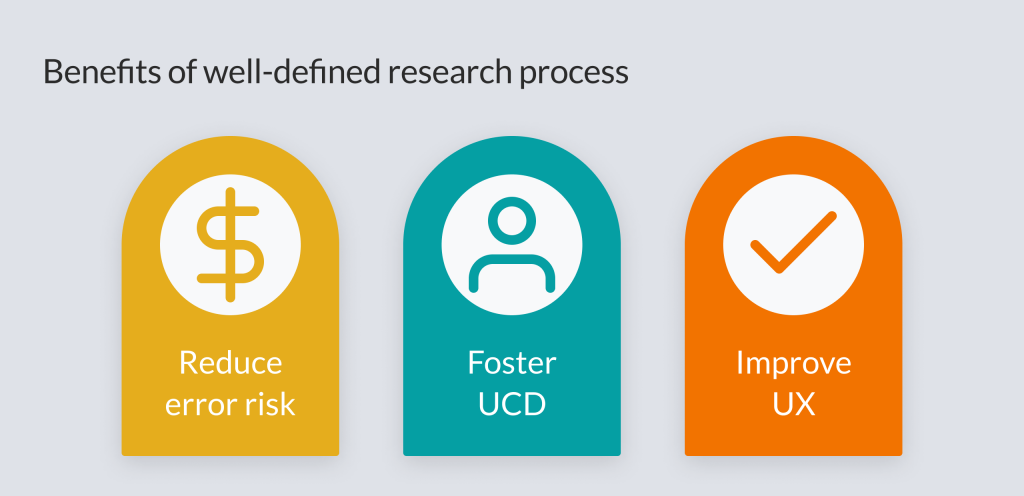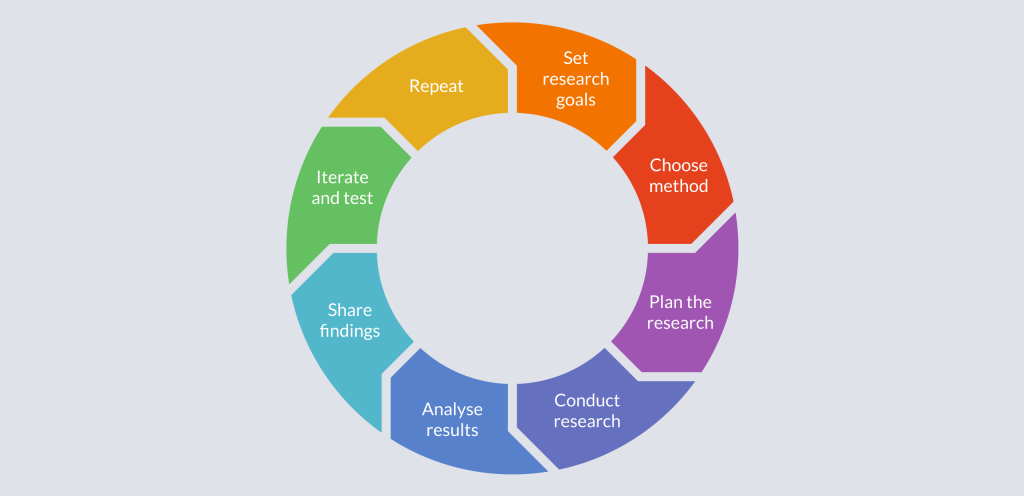
At its core, the UX research process is a procedure of gaining an understanding of users to inform and guide the design and development of digital products.
It involves a series of well-defined steps that allow one to unravel the intricacies of user behavior. This process empowers designers and stakeholders to make informed decisions, fostering the creation of digital products that place the user’s experience at its center.
Let’s discuss the typical steps in a UX research process.

A UX research process is a systematic approach to understanding users and their needs. It is a comprehensive plan of all the needed research, and it is essential for creating products that are user-friendly and aligned with user expectations.
A well-defined UX research process can help to maximize benefits coming from user research, which is:
In short, a UX research process is essential for creating successful and user-friendly products.

The foundational step in any UX research process is setting clear, well-defined research goals.
To identify your research goals, consider what exactly you are trying to learn. This core question will be refined into specific, actionable, and practical research questions that will help you select the correct research method.
To further help you choose the research goals, imagine the results of your study. What outcomes do you anticipate? What would you consider an exhaustive amount of data?
Furthermore, consider the context in which you will conduct your research. Consider your company and the stage of your development process. How will your work apply to your company’s goals? What design decision will this research enable?
Once you have considered these questions, you can draft your research goals. It is essential to be as specific as possible and to set measurable goals through research. For example, saying “I want to understand user behavior” is vague and can lead to producing insights that are not actionable. Instead, you could say, “I want to measure how long it takes users to complete a task on our website.”
Here are some examples of well-defined research goals:
Once you have set your research goals, the next step is to choose the appropriate research methods. There are a variety of different methods available, each with its own strengths and weaknesses. The best method for you will depend on your specific research goals and the type of information you are trying to gather.
You will likely select a combination of qualitative and quantitative research methods. Qualitative methods collect in-depth data about people’s experiences and perspectives, while Quantitative methods collect numerical data about people’s behavior and preferences.
Here are some examples of how to combine different research methods:
By carefully choosing your research methods, you can gather the information you need to make informed decisions about your product or service.
Once you have set your research goals and selected your research methods, you can develop a plan for achieving them. The plan should include recruiting participants, collecting and analyzing data, and communicating your research to the stakeholders.
This element serves as the foundational context of your research. It helps the stakeholders to gain a comprehensive perspective that informs of the context that leads to conducting a study and will serve as a justification for selected methods.
For example, assume you are conducting a user research study for an e-commerce website. The description of the project background for your research could look like this:
“We are conducting a UX research study to improve the checkout process on our website. The analytics show that the current checkout process has a high abandonment rate. We need to understand the areas where the checkout process can be improved to make it more user-friendly and efficient.”
This section reports the research goals for this project. It is important to remember that in the context of presenting your work to other team members, it will act as a criteria for evaluating the success of the study.
Continuing the previous example, the research goals for this project would be:
This part of the research plan may seem similar to the research goals. It is a chance to provide more details about the research objectives – what exactly is your team trying to learn? In this research plan section, researchers outline specific questions to uncover the insights necessary to meet the established research goals. These questions should be clear, concise, and strategically structured, aligning with the chosen research methods. They can be qualitative or quantitative, but selecting a research method appropriate for answering them is vital.
Example:
“The research questions for this study are:
In the context of UX design, KPIs measure the success of a product or service’s success in meeting its users’ needs. For example, task completion rate (the percentage of users who can successfully complete a task on a product or service) and time on task (the amount of time it takes users to complete a task on a product or service) are both types of KPIs. These indicators are crucial for quantifying the design’s effectiveness and providing stakeholders with tangible evidence of the study’s outcomes.
Example:
“The KPIs for this study are:
The methodology section of the research plan serves as the blueprint for executing the chosen research methods in a systematic and rigorous manner. Section provides a detailed plan for data collection. It should describe how, where, and when the data will be collected. It may also provide information about possible incentives for the study participants.
Example:
This section should describe characteristics of ideal study participants. It should consider participants’ gender, age, qualities, and abilities that place them in the targeted audience for our product. This section may outline the strategy for recruiting participants and considerations for providing incentives.
Example:
“The ideal participants for this study are online shoppers aged 18-65, male, female, and non-binary. We will recruit participants from our email list and by using a third-party participant recruiting service. We will offer participants a $20 gift card for our shop as an incentive for participating in the study.”
The Script or Guide section of the research plan is where researchers outline the specific instructions, questions, or tasks for participants. It includes the creation of interview scripts, usability testing guides, survey questionnaires, or any other materials essential for data collection.
The script for the user interviews will include questions about the user’s experience with the checkout process, what they liked and disliked about it, and any suggestions they have for improvement.
The usability testing guide will include tasks for users, such as adding items to their cart and completing the checkout process.
The A/B testing will involve randomly assigning users to different versions of the checkout process and then comparing the performance of the different versions.
We at Talebook prepared another article describing producing a user research plan in detail.
Check it out here.
All the previous steps prepared you for this stage. You will use the chosen methodology to answer research questions and to reach the research goals you have set and, afterward, the collected data that will fuel the subsequent analysis.
During this phase, researchers follow a prepared script or guide meticulously. It’s essential to stay flexible during this stage – when appropriate, ask follow-up questions and ask participants to elaborate. This way, you may learn unexpected but crucial information.
Researchers must be mindful of participant reactions and maintain consistency in their approach. They should keep communication with participants clear and build rapport to contribute to the quality of data gathered.
This section of the research process marks the transition from planning to action. Successful execution of the research involves a blend of methodological rigor, interpersonal skills, and the ability to adapt to the nuances of user behavior. As the data starts pouring in, the subsequent stages of the research process will involve the analysis and synthesis of raw data to create meaningful insights.
With the data collected, the next critical phase in the UX research process is the analysis and synthesis of findings. This stage involves delving into the raw data, identifying patterns, and extracting meaningful insights that address the research goals and questions.
Data analysis techniques vary depending on the nature of the data and the chosen research methods. Qualitative data may involve thematic coding, content analysis, or sentiment analysis. Quantitative data may be subjected to statistical analysis to identify trends or correlations.
Once the data is analyzed, the synthesis phase begins. In this stage, researchers connect the dots, drawing overarching conclusions from the individual data points. Synthesis involves creating a coherent narrative that tells the story of the user experience, highlighting key findings and their implications for the design or improvement of the product.
The analysis and synthesis stage bridges data collection and actionable insights. The goal is not just to present data but to distill it into meaningful and digestible insights that inform decision-making. This section of the research process requires a balance of analytical skills, creativity, and a deep understanding of the project’s context and goals.
In the subsequent sections of the research process, the focus will shift to interpreting findings, generating recommendations, and presenting the outcomes to stakeholders in a compelling and actionable manner.
Having meticulously analyzed and synthesized the research findings, the next crucial step in the UX research process is sharing those insights effectively. This phase involves crafting a comprehensive and compelling report or presentation that communicates the key discoveries, implications, and recommendations derived from the research.
The findings should be presented in a clear and accessible manner, catering to a diverse audience that may include designers, developers, product managers, and other stakeholders. Visual aids such as charts, graphs, and user personas can enhance the communication of complex information.
The report should start by reiterating the research goals and questions, providing context for the findings. It should then delve into the main discoveries, using evidence from the data to support each insight. Clear and concise recommendations, grounded in the research findings, should be articulated to guide future decision-making.
Effective communication is critical during this phase. Presenting the findings as compelling and relatable helps ensure that stakeholders grasp the significance of the insights and are motivated to take action. Whether through a written report, a formal presentation, or a combination of both, sharing the findings marks the culmination of the research journey and the beginning of the impact it will have on the design or improvement of the product.
In the subsequent sections of the research process, the focus will shift to implementing changes based on the findings, iterating on designs, and initiating further research cycles to improve user experience continuously.
Iteration and testing represent a continuous improvement loop in the UX research process. After sharing findings and recommendations, the next step involves implementing changes and refinements based on those insights. This phase is iterative, acknowledging that the first iteration of a design is rarely the final one.
Design modifications are implemented based on the research findings and recommendations. These changes could range from minor adjustments to major overhauls, depending on the nature of the insights gained. Once the changes are made, the next crucial step is to test them.
Testing serves as a validation mechanism for the implemented changes. Usability testing, A/B testing, or other relevant testing methodologies are employed to assess how users interact with the modified design. This phase provides valuable feedback on the effectiveness of the changes and helps identify any unforeseen issues or opportunities for further improvement.
The iterative and testing phase is integral to the user-centered design process. It ensures that design decisions are not made in isolation but are continually refined based on real user feedback and behavior. This cyclical process of iteration and testing enhances the user experience, aligning the product more closely with user needs and expectations.
As the cycle repeats, each iteration builds upon the lessons learned from the previous one, fostering a dynamic and user-centric approach to design. In the subsequent stages of the UX research process, the focus may shift back to setting new research goals, choosing methods, planning, and conducting further research to inform subsequent iterations.
The UX Research process is over, but it’s not actually over. Every product will benefit from its continuous improvement. This cyclical nature of UX research emphasizes that understanding user needs and refining designs is an ongoing journey rather than a one-time event.
It’s crucial to revisit the initial step of setting research goals. As the product evolves, user needs and market dynamics may change. By reassessing goals, the research team can ensure that their efforts stay aligned with the broader objectives of the project.
Following this, the research team revisits the selection of research methods. Depending on the goals and the nature of the product, different methods may be more suitable at different stages. The choice of methods should be flexible and adapted to the project’s evolving requirements. The stage of product development probably changed. Methods used to collect data should change as well.
The repetition of the UX research process also involves refining the research plan and adjusting based on lessons learned from previous iterations. As the team gains experience and accumulates data, the planning phase becomes an opportunity to optimize strategies, streamline processes, and enhance the efficiency of future research endeavors.
Ultimately, the commitment to repetition in the UX research process reflects a dedication to continuous learning and improvement. By staying attuned to user feedback, adapting to changing circumstances, and iterating on designs, teams can create products that meet and exceed user expectations. This cyclical approach is at the core of a user-centered design philosophy, fostering an environment of constant evolution and innovation.
Being an advocate for the need for user research is a significant but overlooked part of being a UX researcher. At some point, you will be put in the position to justify conducting research before jumping straight into development.
Effectively demonstrating the value of UX research is crucial for garnering support and recognition within an organization. By combining qualitative and quantitative evidence, along with compelling narratives, you can convey the significance of UX research and its impact on the overall success of a product or service.
Here are some additional tips for demonstrating the value of UX research:
By following these tips, you can effectively demonstrate the value of UX research and build support for your work.
A 7-step adaptable research process
UX Research Cheat Sheet by Susan Farrell